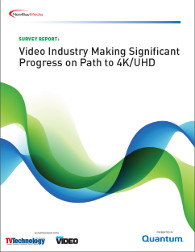Workflow Must Evolve to Support 4K/UHD
Think you know all there is to know about 4K? Think again, says a new survey on this industry-changing format.
Whether it’s because of the stunning images, the relative ease of upconversion, the affordable price of the technology or a combination of all of these advantages, a growing number of broadcast and post-production organizations have welcomed 4K/Ultra HD into their everyday production workflows.

But the industry is being pushed to think beyond the initial purchase of 4K cameras to consider how this new format will impact workflow steps down the line—from editing technology all the way down to archiving.
A new survey conducted by TV Technology magazine and Quantum found a gap in expectations regarding the impact that these changes will have on basic infrastructure within broadcast and post-production facilities.
The report surveyed more than 400 media professionals about both the past and the future and asked respondents:
- What workflow changes have they already experienced during their transition to 4K?
- What changes do they still anticipate as they continue to upgrade their facilities to support 4K/UHD content production?
Get the TV Tech Newsletter
The professional video industry's #1 source for news, trends and product and tech information. Sign up below.
The findings were eye-opening. While 73 percent of respondents said that it was necessary to take initial steps such as upgrading or replacing cameras when adopting a 4K infrastructure, there were a few puzzling findings.
For example, only 37 percent of respondents expected they would need to upgrade or replace the network within the studio. This may mean that respondents are counting on advanced compression techniques to reduce the impact of larger 4K streams on their networks. Or perhaps these responses reveal that many media professionals have not yet come to terms with the full impact that 4K formats will have on their workflow and storage.
The survey also provided revealing information about the relationship between 4K and storage. Concerns about storage featured in two of the top four responses, namely anticipating increased storage costs and the need to upgrade or change storage architecture. After all, 4K comes with larger image sizes (quadruple the number of pixels used by 1080p) and higher data rates (eight times the bit rate of 720p or 1080i HD-SDI links). It is only logical to conclude that 4K/UHD signals will require larger amounts of storage and might also benefit from upgraded storage architecture.
“Even though overall penetration of 4K televisions in consumers’ hands remains low, video content production workflows have begun making the transition to a 4K/UHD future,” says Wes Simpson, industry consultant and architect of the 4K survey. “[New] activity on the consumer side [means] content providers are being forced to develop plans for making the transition to produce and deliver UHD content,” he says.
Plans are indeed being made.
Half of those who responded to the survey are using 4K in their facilities; the next group of adopters plan to do so within the next 24 months. That means that more than 70 percent of all organizations surveyed plan to invest in 4K by 2018.
It’s clear that 4K/UHD is becoming a key piece of mainstream workflows—starting with the camera and flowing through to archives. The key for both broadcast and post-production operations is to think about what kind of upgrades they will need to make—and when—to handle the flood of 4K/UHD content coming downstream.
RESOURCES

Quantum StorNext 5 Solutions: Broadcast
Smoothing the Transition to a 4K/UHD Future
From Hyper to Reality: How Does the Transition to 4K/UHD Really Affect Your Business
